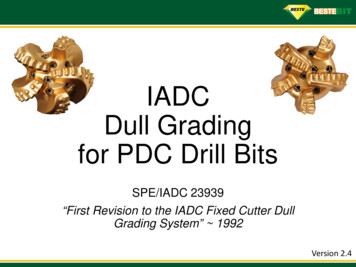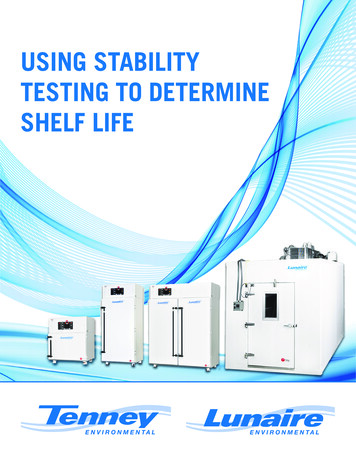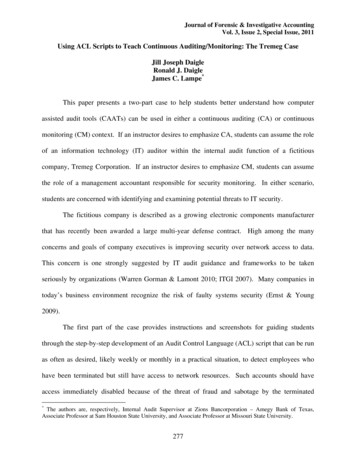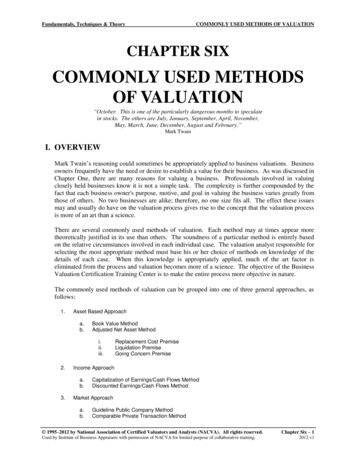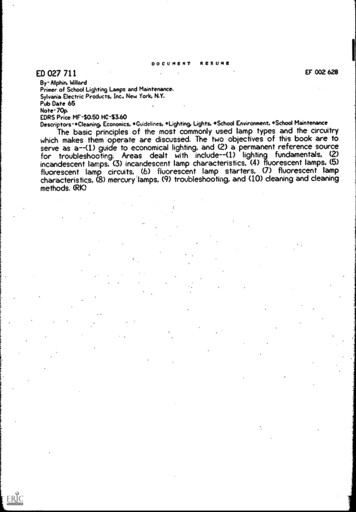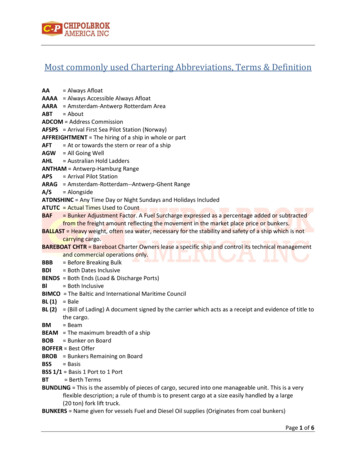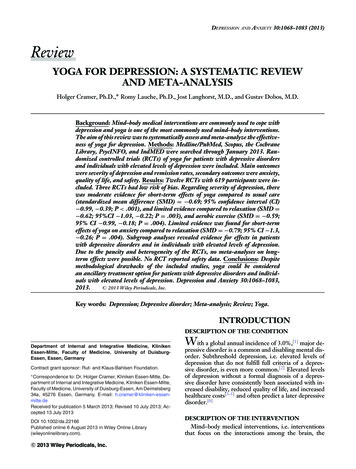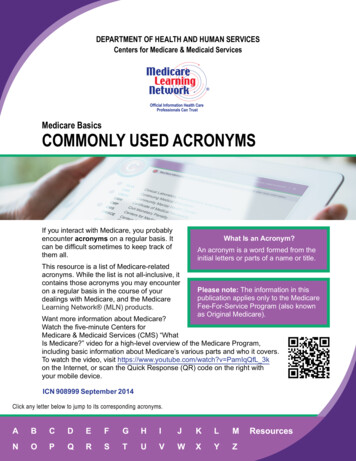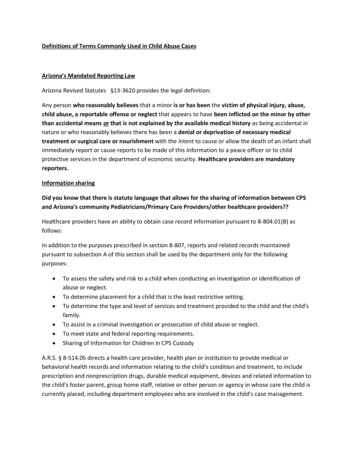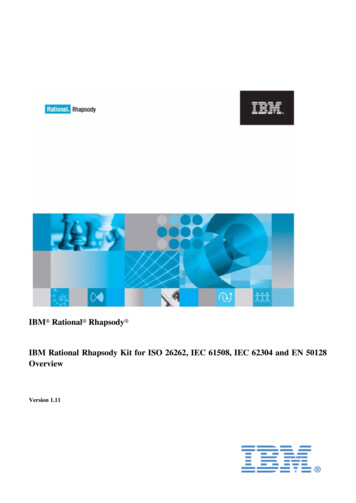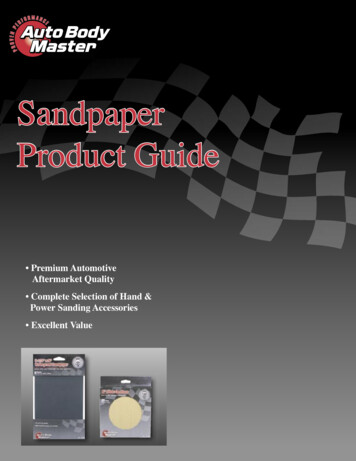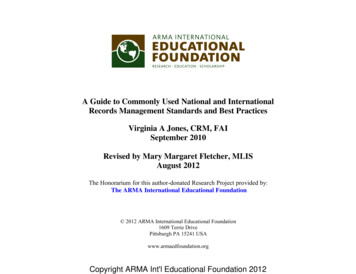
Transcription
A Guide to Commonly Used National and InternationalRecords Management Standards and Best PracticesVirginia A Jones, CRM, FAISeptember 2010Revised by Mary Margaret Fletcher, MLISAugust 2012The Honorarium for this author-donated Research Project provided by:The ARMA International Educational Foundation 2012 ARMA International Educational Foundation1609 Terrie DrivePittsburgh PA 15241 USAwww.armaedfoundation.orgCopyright ARMA Int'l Educational Foundation 2012
TABLE OF CONTENTSIntroduction . 3RIM General . 3Protection .13Technology .17Legality .33Longevity .34A Guide to Commonly Used National and International Records Management Standards and Best PracticesCopyright ARMA Int'l Educational Foundation 20122
IntroductionThis guide is a compilation of key National and International Records Management Standards and Best Practices available for use in recordsand information management. It is not all-inclusive. Standards and best practices for specific industry groups, such as legal profession, realestate, or banking, are not included. The standards, guidelines, and best practices that have been included were selected for their universalusefulness for most or all RIM programs. Each standard or guideline includes a brief description, usually the published Scope or Purpose,when available.Standards can be a standard set of requirements (de jure) or a best practice or procedure (de facto). Most guidelines are informative andtechnical reports cover the informative technical aspects of an issue. RIM professionals use standards as an integral part of active, inactiveand vital records management programs. National and international standards exist that aid in determining the best methods, rationale,environment, and housing for managing and protecting records.Standards provide a measurable benchmark for evaluating RIM practices based on proven best practices from a variety of sources. They cancreate measurable methods of accomplishing work processes and tasks and allow interoperability and compatibility of equipment andproducts. Standards are not required unless adopted by an organization or government entity as a requirement. Adopting and using st andardsprovides consistency of products and services.There are a myriad of national and international standards, guidelines, best practices and technical reports available for purchase or freedownload. Wading through the voluminous list in order find those that are useful in establishing and maintaining good records andinformation management can be time-consuming. Many standards must be purchased before full understanding of their scope and coveragecan be reached.StandardScopePurposePart 1 ISO 15489 provides guidance on managing records oforiginating organizations, public or private, for internal and externalclients. All the elements outlined in Part 1 are recommended toensure that adequate records are created, captured and managed.Procedures that help to ensure the management of records accordingto the principles and elements outlined in this part of ISO 15489 areprovided in ISO/TR 15489-2 (Guidelines).This part of ISO 15489 applies to the management of records, in all formats or media,created or received by any public or private organization in theconduct of its activities, or any individual with a duty to createIntroductionThe standardization of records management policies andprocedures ensures that appropriate attention and protection isgiven to all records, and that the evidence and information theycontain can be retrieved more efficiently and effectively, usingstandard practices and procedures.This part of ISO 15489 was developed in response toconsensus among participating ISO member countries tostandardize international best practice in records managementusing the Australian Standards AS 4390, Records managementas its starting point.RIM GeneralISO 15489-1:2001Information andDocumentation-RecordsManagement-Part 1:GeneralA Guide to Commonly Used National and International Records Management Standards and Best PracticesCopyright ARMA Int'l Educational Foundation 20123
ISO/TR 15489-2:2001Information andDocumentation-RecordsManagement-Part 2:Guidelinesand maintain records, provides guidance on determining the responsibilities oforganizations for records and records policies, procedures,systems and processes, provides guidance on records management in support of a qualityprocess framework to comply with ISO 9001 and ISO 14001, provides guidance on the design and implementation of a recordssystem, but does not include the management of archival recordswithin archival institutions.This part of ISO 15489 is intended for use by managers of organizations, records, information and technology management professionals, all other personnel in organizations, and other individuals with a duty to create and maintain records.This International Standard is accompanied by a TechnicalReport (ISO/TR 15489-2) that is recommended for use with it.ISO/TR 15489-2 provides further explanation andimplementation options for achieving the outcomes of thisInternational Standard. It also includes a bibliography.This part of ISO 15489 is an implementation guide to ISO 15489-1for use by record management professionals and those charged withmanaging records in their organizations. It provides onemethodology that will facilitate the implementation of ISO 15489-1in all organizations that have a need to manage their records. It givesan overview of the processes and factors to consider in organizationswishing to comply with ISO 15489-1.IntroductionThis part of ISO 15489 provides guidelines that aresupplementary to ISO 15489-1. Both ISO 15489-1 and this partof ISO 15489 apply to records in any format or media, createdor received by any public or private organization during thecourse of its activities. Thus, in this part of ISO 15489, unlessotherwise noted, systems may be interpreted as paper/manualor electronic, and a document may be either paper, microformor electronic.ISO 15489-1 specifies the elements of records managementand defines the necessary results or outcomes to be achieved.This part of ISO 15489 provides one methodology forimplementation. However, it should be noted that nationalstandards and legislation and regulation may dictate otherfactors and requirements for legal compliance.In addition to using this part of ISO 15489, those seeking toimplement the standard should consult requirements andguidance of national standards and legislation and regulationthat apply in their jurisdictions. In addition, a variety ofprofessional societies and associations have resources availableto assist in the implementation of ISO 15489-1.A Guide to Commonly Used National and International Records Management Standards and Best PracticesCopyright ARMA Int'l Educational Foundation 20124
ISO/TR 26122:2008Information anddocumentation — Workprocess analysis for recordsThis Technical Report provides guidance on work process analysisfrom the perspective of the creation, capture and control of records.It identifies two types of analyses, namelya) functional analysis (decomposition of functions intoprocesses), andb) sequential analysis (investigation of the flow oftransactions).Each analysis entails a preliminary review of context (i.e. mandateand regulatory environment) appropriate for the analysis. Thecomponents of the analysis can be undertaken in variouscombinations and in a different order from that described here,depending on the nature of the task, the scale of the project, and thepurpose of the analysis. Guidance provided in the form of lists ofquestions/matters to be considered under each element of theanalysis is also included.This Technical Report describes a practical application of the theoryoutlined in ISO 15489. As such, it is independent of technology (i.e.can be applied regardless of the technological environment),although it can be used to assess the adequacy of technical tools thatsupport an organization's work processes.This Technical Report focuses on existing work processes ratherthan on facilitating “workflow” (i.e. the automation of a businessprocess in whole or part, during which documents, information ortasks are passed from one participant to another for action, accordingto a set of procedural rules as outlined in Reference [1] of theBibliography).ARMA InternationalGuideline 2007Glossary of Records andInformation ManagementTerms: 3rd EditionPurpose and ScopeThis glossary is intended for anyone whose work includes recordsand information management. Terms were included from numerousdisciplines that have an impact on the profession, including recordsmanagement, information technologies, legal, business, andarchives.Terms that have no particular records connotation were generallyexcluded. In addition, terms that have very specific and narrowusage and that are not common to records management, such astechnical terms for archival or library science concepts and forspecific technologies, were excluded.Work process analysis for records is undertaken to determinethe requirements for records creation, capture and control. Itdescribes and analyses what happens in a function in a specificbusiness context. It cannot take place in the abstract but isdependent on accurate information gathering and a wellgrounded understanding of the organization's context andmission.This Technical Report is intended for: records professionals (or persons assigned withinan organization for managing records)responsible for creating and managing records ineither a business system or dedicated recordsapplication software; system/business analysts responsible fordesigning business processes and/or systems thatwill create or manage records.A Guide to Commonly Used National and International Records Management Standards and Best PracticesCopyright ARMA Int'l Educational Foundation 20125
ANSI/ARMA 8-2005Retention Management forRecords and InformationThis standard covers general principles in structuring an informationretention and disposition program, including authority andresponsibility, identifying and classifying records for retentionpurposes, and principles for determining retention periods for allrecords. The principles enumerated apply to records on all media andin all formats, including but not limited to paper, microform,magnetic tape, personal computer hard disks, diskettes, and CDs.Organizations must apply these principles in compliance with thelegal and policy requirements of the institutional context withinwhich they operate.This standard provides guidance for establishing and operatingan information retention and disposition program as acomponent of a complete records and information management(RIM) program. When implemented, the information retentionand disposition program will define periods of time for whichrecords are to be maintained, appropriate methods fordisposition of records, and measures to be taken whendisposition must be suspended. Such a program will helpensure compliance with operational, legal/regulatory, fiscal,archival, and other requirements.ANSI/ARMA 12-2005Establishing Alphabetic,Numeric and Subject FilingSystemsThis standard contains requirements for subject, alphabetic, andnumeric filing systems. The alphabetic guidelines can be used forarrangement of indices or within subject and alphanumeric filingsystems. Alphabetic filing is a method for arranging data within afiling system or index, as well as a filing system. Although thisstandard is intended to be used with all media, some exceptions,such as leading zeroes, may occur with electronic systems.The standardization of filing systems ensures that all records,regardless of media, are properly and consistently housed,identified, and maintained so that they may be efficiently andeffectively retrieved using standard equipment, practices, andprocedures. This standard is recommended as a reference forfiling, storing, and retrieving active records.ARMA InternationalGuideline 2008Controlled Language inRecords and InformationManagementForewordThe purpose of this guideline is to provide records and informationmanagement professionals, and those responsible for administrativeand financial decisions about records management, with anunderstanding of what controlled language is, and why usingcontrolled language can provide benefits to the organization.Controlled language (CL) is an umbrella term that indicates anagreed upon use of language in a predetermined or predictable wayfor the description of organizational information resources,regardless of the format of the resource (media neutral). Use ofcontrolled language tools (often called controlled vocabularies) hasthe following advantages: Reduced search time Increased reliability of search results Improvement in organizational communication Avoidance of duplication Reduced corporate risk exposure in legal and otherdiscovery processesThis guideline describes the benefits of using controlled language,methods for deriving terms for controlled language tools and variousIn many parts of the world, the use of controlled language (CL)is already an essential component of best practices for recordsand information management (RIM). A March 2006 surveyconducted by ARMA International indicated that a third ofrecords managers already make use of CL to improveinformation retrieval.The purpose of this guideline is to provide RIM professionals,as well as those responsible for administrative and financialdecisions, with an understanding of CL, and why using CL canprovide benefits to the organization. This guideline provides: Terms and definitions An explanation of CL Benefits of using CL The process for creating CL tools Management of a CL implementation Case study of a CL implementation Related industry and international standards References and links to useful resourcesA Guide to Commonly Used National and International Records Management Standards and Best PracticesCopyright ARMA Int'l Educational Foundation 20126
tools in use today, information on managing the creation andmaintenance of controlled language tools, and some current industrystandards for records management and controlled language tools. Italso provides a sample case study and resources for furtherinformation.Finally, the guideline shows how collaboration between businessfunctional management, records and information managers, and IT(information technology) professionals will increase the success ofcontrolled vocabulary implementations and records managementefforts as a whole.ANSI/ARMA TR01-2011Records Center OperationsThis publication, which revises and updates the second edition of thetechnical report, Records Center Operations, ARMA TR 01-2002,covers the establishment and operation of a records center eitherunder direct control of an organization or through the use of acommercial records center. For this new version of this technicalreport, safety issues have been incorporated into the content of thepublication.Although this publication may be useful to archivists, it is notinclusive of the specific needs of an archival records center.Establishing and operating an archival records center requires a morestringent look at temperature/humidity controls, storage supplies,and equipment needed for longterm storage of records and/orobjects. For the proper methods for storage of archival information,refer to the Standard for Record Repositories from the U.K. NationalArchives for additional guidance.Electronic records in an organization must also be properly managedand sometimes the records center may be responsible for themanagement of those records. This technical report does not detailthe management or storage of electronic records, which are coveredin the ARMA International publication Guideline for OutsourcingElectronic Records Storage and Disposition.Governmental records have certain guidelines that must be met forboth on-site and offsite storage. Facility Standards for Records, Part1234 of the Code of Federal Regulations developed by theNational Archives and Records Administration (NARA), should beconsulted on how to handle and store governmental records. Becauseeach government entity may have additional rules and guidelines,consult the respective entity for additional requirements.The purpose of this technical report is to provide revised andupdated advice for establishing and operating a records center.A records center is “a low-cost centralized area for housing andservicing inactive or semi-active records whose reference ratedoes not warrant their retention in a prime office space. Arecords center may occupy an independent building or aportion of a building, depending on the need of theorganization.The need to store information to meet its administrative,operational, legal, and historical values, regardless of media, isan essential part of any well-organized records managementprogram. The advantages of a records center are becomingmore meaningful, given that the costs of prime commercial realestate are considerable and the need for physical storageenvironments remains a growing concern. Although paper andmicrofilm have been the major information storage media inthe past, today’s records centers must be able to accommodateelectronic information storage as well.Records center operations should be a part of an overall recordsmanagement program and storage requirements should bebased on records analysis and appraisal. A records manager’sresponsibility is to decide which records need to be maintainedand to determine the most cost-effective methods to house andmanage them.Maintenance of a records center provides organizations withthe following benefits: Economy— Less costly storage space is used for inactive and semi-A Guide to Commonly Used National and International Records Management Standards and Best PracticesCopyright ARMA Int'l Educational Foundation 20127
active records, allowing prime office space to be reallocated formore productive purposes.— Less costly storage equipment, such as steel shelving andstandard-size boxes, can be used instead of expensive filingcabinets.— New construction for inactive file storage space inarchitecturally more expensive office space can be avoided. Accessibility/Accountability— Organization and individual identification can enhancecontrol.— A well-organized records center can provide more accurateand efficient retrieval of records. Security— Confidentiality is enhanced by controlling and monitoringaccess.— Legal, secure, and timely disposal of records can beprovided, once destruction is authorized.ARMA InternationalGuideline 2007Guideline for EvaluatingOffsite Records StorageFacilitiesThis ARMA International guideline provides guidance in theevaluation of and negotiation with commercial storage facilities forthe storage of business records in physical form (e.g., paper,microfilm, backup tapes, and media), as well as related informationservices. This guideline does not include issues related to offsitestorage of electronic records and information such as datawarehousing or electronic systems established for businesscontinuity purposes.This guideline does not specifically address compliance withindustry standards or legislative requirements such as NFPA,NARA, or any local inspection codes for protection and storage incommercial facilities. However, users are encouraged to becomefamiliar with specific requirements for applicable local, national, andinternational standards. Additionally, communication withprospective storage providers may help determine the level to whichthey are in compliance with such guidelines and what types offacilities are generally available within their geographic area.Different countries may have national or regional storage guidelinesand archival standards. Some of them have been published by eachcountry’s national archives or state or provincial governmentagencies. Other records storage standards have been promulgated byThis guideline is designed as a practical tool for individualsand organizations seeking to evaluate current businesspractices and determine whether to outsource inactive records.It identifies components critical to making an offsite storagedecision based on a range of factors including records securityand protection, service levels, and contract terms in addition tocost comparisons.A Guide to Commonly Used National and International Records Management Standards and Best PracticesCopyright ARMA Int'l Educational Foundation 20128
standards organizations and professional associations. Although notall will apply to any given situation, the publications may serve asvaluable reference points during the evaluation process.ARMA InternationalGuideline 2009Contracted Destruction forRecords and InformationMediaRecords are captured, processed, and stored on a wide variety ofmedia. The proper destruction of these records at the end of thelifecycle is a primary concern of records management. Timely andeffective destruction of records is cost effective, ensures compliancewith policies and regulations, and restricts unauthorized access tosensitive information. This guideline is not meant to be all-inclusivefor issues related to contracted destruction, and it does not providelegal advice or counsel.The purpose of this publication is to provide assistance in theestablishment of an organization’s destruction policy and theselection of an appropriate third-party vendor for contracteddestruction. It provides records and information managementprofessionals with the most current advice, and it offers bestpractices guidance to alert an organization about potentialpitfalls and inefficiencies. In addition, the appendices containsample forms and examples of certificates and policies for thereader’s review and use.ISO 9000-2005Quality management systems– Fundamentals andvocabularyThis International Standard describes fundamentals of qualitymanagement systems, which form the subject of the ISO 9000family, and defines related terms.This International Standard is applicable to the following:a. Organizations seeking advantage through theimplementation of a quality management systemb. Organizations seeking confidence from their suppliers thattheir product requirements will be satisfiedc. Users of the productsd. Those concerned with a mutual understanding of theterminology used in quality management (e.g. suppliers,customers, regulators)e. Those internal or external to the organization who assessthe quality management system or audit it for conformitywith the requirements of ISO 9001 (e.g. auditors,regulators, certification/registration bodies)f. Those internal or external to the organization who giveadvice or training on the quality management systemappropriate to that organizationg. Developers of related standardsIntroductionGeneral:The ISO 9000 family of standards has been developed to assistorganizations, of all types and sizes, to implement and operateeffective quality management systems. ISO 9000 describesfundamentals of quality management systems and specifies theterminology for quality management systems.This International Standard specifies requirements for a qualitymanagement system where an organizationa. needs to demonstrate its ability to consistently provideIntroductionThe adoption of a quality management system should be astrategic decision of an organization. The design andISO 9001:2008Quality management systems– RequirementsQuality management principles:To lead and operate an organization successfully, it isnecessary to direct and control it in a systematic andtransparent manner. Success can result from implementing andmaintaining a management system that is designed tocontinually improve performance while addressing the needs ofall interested parties. Managing an organization encompassesquality management amongst other management disciplines.A Guide to Commonly Used National and International Records Management Standards and Best PracticesCopyright ARMA Int'l Educational Foundation 20129
b.product that meets customer and applicable statutory andregulatory requirements, andaims to enhance customer satisfaction through the effectiveapplication of the system, including processes for continualimprovement of the system and the assurance of conformityto customer and applicable statutory and regulatoryrequirementsNotes: In this International Standard, the term “product” applies onlyto the product intended for, or required by, a customer; or anyintended output resulting from the product realization process.Statutory and regulatory requirements can be expressed as legalrequirements.ISO 9004-2009Managing for the sustainedsuccess of an organization—A quality managementapproachThis International Standard provides guidance to support theachievement of sustained success by a quality managementapproach. It is applicable to any organization, regardless of size, typeand activity. This International Standard is not intended forcertification, regulatory or contractual use.implementation of an organization’s quality managementsystem is influenced by its organizational environment,changes in that environment, and the risks associated with thatenvironment; its varying needs; its particular objectives; theproducts it provides; the processes it employs; and its size andorganizational structure. It is not the intent of this InternationalStandard to imply uniformity in the structure of qualitymanagement systems or uniformity of documentation.The quality management system requirements specified in thisInternational Standard are complementary to requirements forproducts. Information marked “NOTE” is for guidance inunderstanding or clarifying the associated requirements. ThisInternational Standard can be used by internal and externalparties, including certification bodies, to assess theorganization’s ability to meet customer, statutory andregulatory requirements applicable to the product, and theorganization’s own requirements. The quality managementprinciples stated in ISO 9000 and ISO 9004 have been takeninto consideration during the development of this InternationalStandard.IntroductionThis International Standard provides guidance to support theachievement of sustained success for any organization in acomplex, demanding, and ever-changing environment, by aquality management approach.The sustained success of an organization is achieved by itsability to meet the needs and expectations of its customers andother interested parties, over the long term and in a balancedway. Sustained success can be achieved by the effectivemanagement of the organization, through awareness of theorganization’s environment, by learning, and by theappropriate application of either improvements, innovations, orboth.This International Standard promotes self-assessment as animportant tool for the review of the maturity level of theorganization, covering its leadership, strategy, managementsystem, resources and processes, to identify areas of strengthand weakness and opportunities for either improvements, orinnovations, or both.A Guide to Commonly Used National and International Records Management Standards and Best PracticesCopyright ARMA Int'l Educational Foundation 201210
This International Standard provides a wider focus on qualitymanagement than 9001; it addresses the needs and expectationsof all relevant interested parties and provides guidance for thesystematic and continual improvement of the organization’soverall performance.ISO 14001-2004Environmental managementsystems – Requirements withguidance for useThis International Standard specifies requirements for anenvironmental management system to enable an organization todevelop and implement a policy and objectives which take intoaccount legal requirements and other requirements to which theorganization subscribes, and information about significantenvironmental aspects. It applies to those environmental aspects thatthe organization identifies as those which it can control and thosewhich it can influence. It does not itself state specific environmentalperformance criteria.This International Standard is applicable to any organization thatwishes toa. Establish, implement, maintain and improve anenvironmental management systemb. Assure itself of conformity with its stated environmentalpolicyc. Demonstrate conformity with this International Standard by1. making a self-determination and self-declaration,or2. seeking confirmation of its conformance by partieshaving an interest in the organization, such ascustomers, or3. seeking confirmation of its self-declaration by aparty external to the organization, or4. seeking certification/registration of itsenvironmental management system by an externalorganization.All the requirements in this International Standards are intended tobe incorporated into any environmental management system. Theextent of the application depends on factors such as theenvironmental policy of the organization, the nature of its activities,products a
Glossary of Records and Information Management Terms: 3rd Edition Purpose and Scope This glossary is intended for anyone whose work includes records and information management. Terms were included from numerous disciplines that have an impact on the profession, including records management, information technologies, legal, business, and archives.

